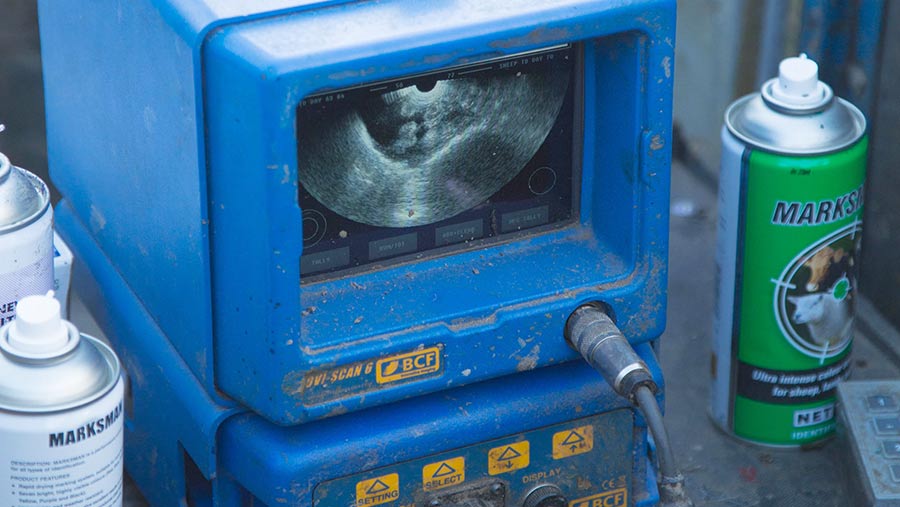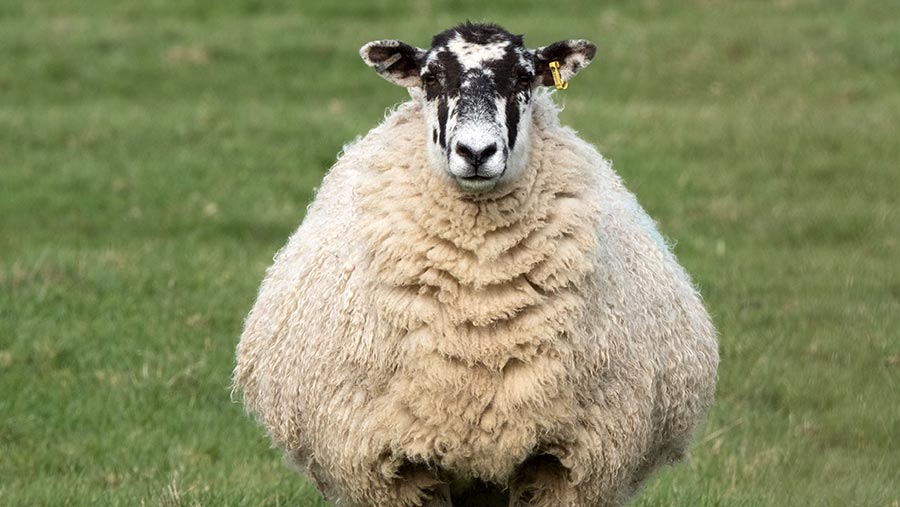Advice on feeding pregnant ewes when winter fodder stocks low
 Twin and triplet-bearing ewes should be run as a separate group after the flock is scanned
Twin and triplet-bearing ewes should be run as a separate group after the flock is scanned When there is pressure on flocks from a limited grazing season and subsequent winter fodder deficits, planning the feeding and management of pregnant ewes is more critical than ever during winter.
Independent sheep specialist Kate Phillips gives her advice on how to keep ewes well fed in the lead up to lambing.
What should farmers do?
As a starting point, assess the amount of dry matter (DM) available from grazed grass, up to the point in the year where it will stop growing; work out the number of grazing days available in fodder crops and the volume of conserved forage.
Work out what DM you have and how many animals it must feed.
For outdoor flocks, ewes mated in good condition (BCS 3) require 3-4 cm pasture height for maintenance feeding during the winter, increasing to 4-6cm from four to six weeks before lambing.
If you are going to be short, put a plan in place to address this.
There is evidence that it is beneficial to maintain BCS throughout pregnancy. Therefore, it might be better to sell lambs as stores or reduce ewe numbers by more rigorous culling, selling cull ewes earlier or buying in additional forage.
Should I blood test to look for deficiencies?
If the BCS of ewes is at the correct level, the ration has been formulated to provide the necessary balance of nutrition and all ewes can get their fair share, there are limited benefits from blood testing.
If body condition is good, there is also far less chance of metabolic problems.
But if there is doubt over body condition or the make-up of the ration, metabolic profiling can be useful for identifying where a ration might be falling short.
Ask your vet to take blood samples at three to four weeks before lambing to give you an idea of their energy and protein status.
How can I best match purchased feeds with forages and what key ingredients should they supply?
Any deficit in energy intake and dry matter intake (DMI) not supplied by forage must be provided by supplementary feeds, but this will have consequences for rumen pH and forage intake so this must be considered when rationing.
The type of supplement to feed depends on the energy and protein requirements of the sheep, availability, forage quality, cost and convenience.
First, get silage and hay analysed to understand what level of supplementation will be needed. A saving of at least 10kg of compound per ewe can be made for every 1 MJ improvement in silage quality.
Compare relative values to the cost of bought-in feed. Although the fresh weight cost might look attractive, the nutrients provided and the DM percentage vary according to the product.
For instance, at 65-75% DM, molasses is a relatively high DM product; dry grain also has a high DM content but fodder beet is a low DM feed source.
Concentrate feeds should contain 16-20% protein – according to forage quality – with a good source of digestible undegradable protein (DUP) and an energy level in the region of 12MJ/ME/kg DM or higher.
Often the higher quality products represent the best value for money.
Most raw material prices have increased in price by about £50/t compared with last year, but compounds need to contain cereals to provide fermentable carbohydrates, by-products to provide fibre, protein and energy, good sources of protein such as rapeseed meal and soya, and balanced minerals and trace elements.
When and how should I supplement with protein?
Requirements for metabolisable protein (MP) rise during the last seven weeks of pregnancy and demand increases further in the final three weeks.
For a 70kg ewe carrying twins, the MP requirement between seven weeks and one week pre-lambing increases by 60%; these requirements do vary according to her weight and BCS, the number of lambs carried and whether she is gaining, losing or maintaining weight.
Metabolisable energy requirements of housed pregnant ewes (MJ/day) based on a diet of 11MJ/kg DM assuming no ewe weight loss |
|||||
|
Ewe liveweight (kg) |
Number of lambs |
Seven weeks |
Five weeks |
Three weeks |
One week |
|
50 |
1 |
7.9 |
8.7 |
9.8 |
11.2 |
|
2 |
8.8 |
10.1 |
11.9 |
14.2 |
|
|
60 |
1 |
9.1 |
10 |
11.2 |
12.8 |
|
2 |
10.1 |
11.6 |
13.7 |
16.3 |
|
|
70 |
1 |
10.2 |
11.2 |
12.6 |
14.4 |
|
2 |
11.4 |
13.1 |
15.3 |
18.3 |
|
| 3 |
12 |
14 |
16.7 |
20.3 |
|
|
80 |
1 |
11.3 |
12.4 |
13.9 |
15.9 |
|
2 |
12.6 |
14.4 |
17 |
20.2 |
|
|
3 |
13.3 |
15.5 |
18.5 |
22.5 |
|
|
* For outdoor ewes, increase ME requirements by 0.11MJ for every 10kg bodyweight and 0.24MJ for every 10kg bodyweight for lowland and hill ewes respectively. For ewes gaining 50g daily add 2.5MJ of ME. Source: AFRC, 1993 |
|||||
Should shearlings and ewes be split?
Ewe lambs and shearlings are still growing and are shy feeders so separating them from adult ewes allows these animals to be fed for growth as well as maintenance.
This can only be done if there is sufficient housing or, for outdoor flocks, adequate paddocks. But, if infrastructure does allow, this approach should be taken before tupping.
How much should ewe lambs and shearlings be fed and are there benefits in running twin and triplet-bearing ewes separately?
Pregnant ewe lambs and shearlings are trying to grow as well as produce a lamb so their nutritional requirements are higher than those of a mature ewe.
Two months after rams have been introduced a growth rate of about 130g/day is desirable for ewe lambs until six weeks before lambing.
During early and mid-pregnancy, they need about 20% more feed than mature ewes to sustain growth.
At this stage of pregnancy good grazing would be ideal but if grass is in short supply, moderate quality hay or silage fed to appetite should be supplemented with a high-quality concentrate feed fed at a daily rate of 0.2kg and 0.3kg, respectively, for ewe lambs and shearlings carrying singles and twins.

If grass is in short supply it may be worth reducing flock numbers © Tim Scrivener
During the final six weeks of pregnancy, moderate quality hay or silage fed to appetite should be supplemented with a high-quality concentrate feed fed at a daily rate of 0.25kg and 0.5kg for ewe lambs carrying singles and twins, respectively, but this will be highly dependent on forage quality.
Run twin- and triplet-bearing ewes as a separate group after the flock is scanned at around day 70 of pregnancy, but any time between 40 and 90 days of pregnancy is an acceptable range.
Flat-rate feeding vs step-rate feeding – what are the pros and cons?
The traditional approach is to offer incremental increases in the amount of concentrates as lambing approaches, known as step-rate feeding. But an alternative is to offer the same amount of concentrates as a flat rate throughout late pregnancy.
This reduces the need to feed large quantities as lambing approaches and simplifies feeding overall.
Either approach can be successful but flat-rate feeding is simpler, often allowing for once-a-day feeding, and it reduces the risk of acidosis and prolapse.
However this approach is not advisable for ewes that are not at target condition. Step-rate feeding more closely meets the ewes’ needs in the critical days before lambing so if ewes are too lean this is likely to give better results than flat rate.
Whichever method is used, ensure no more than 0.5kg at any one feed and allow sufficient trough space.
Step rate feeding versus flat rate (kg/ewe/day) |
||||||
| Weeks before lambing |
8 |
6 |
4 |
2 |
1 |
Total |
|
Step rate |
0.4 |
0.6 |
0.8 |
1 |
1.1 |
40 |
|
Flat rate |
0.4 |
0.8 |
0.8 |
0.8 |
0.8 |
40 |
| *70kg twin-bearing ewe on poor hay (8.5MJ kg DM). Source: AHBD | ||||||
